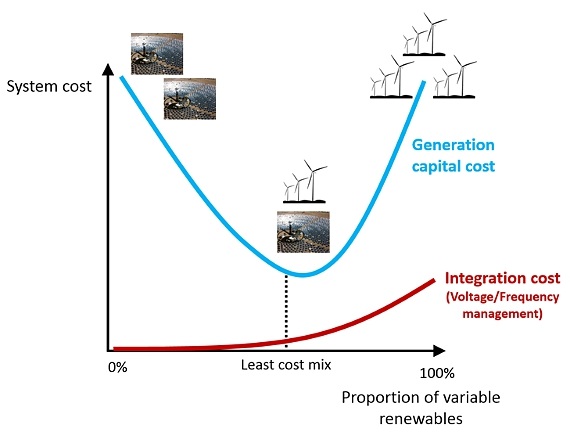Junking the garbage baseload argument
The old catch-cry ‘renewables can’t provide baseload’ continues to haunt discussions about our long-term energy future. But this really misses the fact that we’re moving into an entirely new power system paradigm where baseload (by the traditional definition) won’t be required.
Firstly, let’s identify what we really mean by the term ‘baseload’.
Do we mean the supply of bulk energy at low cost? Renewables can do that. Actually, according to BNEF’s recent discussions with financing organisations, wind can now provide bulk energy more cheaply than coal-fired and gas-fired plant.
Do we mean the provision of firm capacity? Renewables can do that, too. It’s worth remembering that wind and solar photovoltaics are actually relatively unique amongst renewable technologies. They are the least expensive and most widely available renewables and therefore the ones that spring to mind first.
However, hydro, biomass, geothermal and solar thermal with storage are all renewables that are fully dispatchable, similar to fossil fuel technologies in their integration into power systems, commercially available and in use around the world today. While there are likely to be limitations on how much we can scale up hydro, biomass and geothermal in Australia, we have extensive resources for solar thermal with storage. Expensive, but undoubtedly available to provide firm capacity in large quantities if required.
Do we mean both of these things together, in the same technology? This probably is the definition of ‘baseload’ in most people’s minds – cheap bulk energy combined with firm capacity. Any cost effective power system will certainly require both of these things. But why do we require them to be provided from the same technology? Why not get cheap bulk energy from one technology, and firm capacity from another, if that turns out to be lower cost?
As long as both are supplied in the quantities required, it works. In this way, we can combine low cost variable renewables with firm capacity dispatchable renewables to create a 100 per cent renewable power system that is cost effective and reliable, as illustrated in Figure 1.
Figure 1– Illustrative dispatch in the new power system paradigm

To see this in another way, consider that Brazil already sources 85 per cent of their power from renewables, namely hydro. It’s not a far stretch to imagine adding a little wind and solar to increase this to 100 per cent. So of course you can construct a large power system that is 100 per cent renewable, it’s actually pretty ridiculous to suggest otherwise.
In Australia, for a range of reasons we probably can’t scale up hydro much beyond where it is now. However, there is no technical reason that we couldn’t construct a perfectly functioning system entirely composed of solar thermal with storage. This would be very expensive, but there is little doubt that it’s technically feasible.
So the real question is one of cost. Solar thermal technologies are much more expensive than other types of renewables. Integrating more of the cheaper variable renewables (wind and solar PV) will bring down costs, as depicted in Figure 2. Beyond a certain point, however, costs are likely to go back up again, as we start having to install larger and larger capacities of variable generation to provide sufficient reliability (ensuring adequate supply in every interval).
The ‘system management’ costs are also likely to increase as we approach higher penetrations of variable technologies (including aspects such as regulation costs for managing variability). This suggests there will be some optimal least cost mix – a hybrid system that uses the variable technologies for cheap bulk energy supply, partnered with dispatchable renewables (like solar thermal with storage) to provide the firm capacity for reliability.
Figure 2- Optimising the generation mix for 100 per cent renewables

Recent modelling by researchers at the University of NSW, based upon the latest technology cost estimates from the Bureau of Resources and Energy Economics, suggests that this least cost mix for Australia is likely to include around 45-60 per cent wind generation and 15-20 per cent solar PV generation, partnered with 14-22 per cent dispatchable solar thermal with storage and small amounts of hydro and biomass (5 per cent and 6 per cent respectively, respecting resource limitations). Moreover, the study shows that this system is affordable, being cost competitive with a fossil-fuel system by 2030 (given anticipated carbon prices in the range $50-$65 at that time).
So the question of ‘can renewables supply baseload’ really misses the point.
We’re looking at an entirely new power system paradigm where we provide reliability cost effectively without baseload generation. This concept is depicted in Figure 3. Power systems of the past partner relatively inflexible ‘baseload’ technologies (such as coal-fired generation) with more flexible and lower capital cost ‘peaking’ generation (usually gas-fired technologies).
The baseload generators provide the majority of the bulk energy at low cost, while the peaking generators mostly just provide firm capacity (without bulk energy supply), cost effectively matching the variability of demand.
In moving to a 100 per cent renewables power system we need to provide reliability (that is, supply to meet demand in every interval), in a cost effective way. There is absolutely no reason that this needs to be achieved via the development of a ‘baseload equivalent’ renewable technology. Instead, we can more cheaply achieve reliability by combining technologies in the right mix. As depicted in Figure 3, a 100 per cent renewable power system can use the cheapest variable renewable technologies (such as wind and solar PV) to provide bulk energy, partnered with a range of dispatchable renewables to cost effectively provide firm capacity.
Figure 3– Moving towards a new power system paradigm

So the catch-cry ‘renewables can’t provide baseload’ misses the point entirely. We don’t need baseload, that’s just how we’ve done it in the past. It will almost certainly be cheaper to do it differently in the future.
















